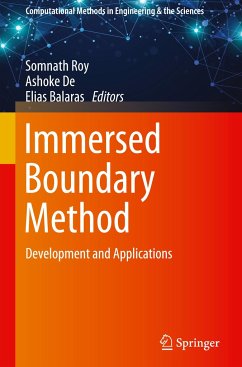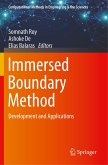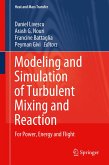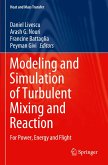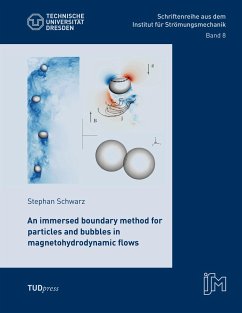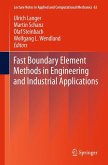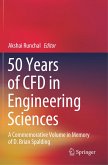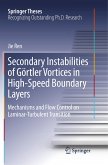Immersed Boundary Method
Development and Applications
Herausgegeben:Roy, Somnath; De, Ashoke; Balaras, Elias
Immersed Boundary Method
Development and Applications
Herausgegeben:Roy, Somnath; De, Ashoke; Balaras, Elias
- Gebundenes Buch
- Merkliste
- Auf die Merkliste
- Bewerten Bewerten
- Teilen
- Produkt teilen
- Produkterinnerung
- Produkterinnerung
This volume presents the emerging applications of immersed boundary (IB) methods in computational mechanics and complex CFD calculations. It discusses formulations of different IB implementations and also demonstrates applications of these methods in a wide range of problems. It will be of special value to researchers and engineers as well as graduate students working on immersed boundary methods, specifically on recent developments and applications. The book can also be used as a supplementary textbook in advanced courses in computational fluid dynamics.
Andere Kunden interessierten sich auch für
![Immersed Boundary Method Immersed Boundary Method]() Immersed Boundary Method38,99 €
Immersed Boundary Method38,99 €![Modeling and Simulation of Turbulent Mixing and Reaction Modeling and Simulation of Turbulent Mixing and Reaction]() Modeling and Simulation of Turbulent Mixing and Reaction77,99 €
Modeling and Simulation of Turbulent Mixing and Reaction77,99 €![Modeling and Simulation of Turbulent Mixing and Reaction Modeling and Simulation of Turbulent Mixing and Reaction]() Modeling and Simulation of Turbulent Mixing and Reaction75,99 €
Modeling and Simulation of Turbulent Mixing and Reaction75,99 €![An immersed boundary method for particles and bubbles in magnetohydrodynamic flows An immersed boundary method for particles and bubbles in magnetohydrodynamic flows]() Stephan SchwarzAn immersed boundary method for particles and bubbles in magnetohydrodynamic flows39,80 €
Stephan SchwarzAn immersed boundary method for particles and bubbles in magnetohydrodynamic flows39,80 €![Fast Boundary Element Methods in Engineering and Industrial Applications Fast Boundary Element Methods in Engineering and Industrial Applications]() Fast Boundary Element Methods in Engineering and Industrial Applications75,99 €
Fast Boundary Element Methods in Engineering and Industrial Applications75,99 €![50 Years of CFD in Engineering Sciences 50 Years of CFD in Engineering Sciences]() 50 Years of CFD in Engineering Sciences134,99 €
50 Years of CFD in Engineering Sciences134,99 €![Secondary Instabilities of Görtler Vortices in High-Speed Boundary Layers Secondary Instabilities of Görtler Vortices in High-Speed Boundary Layers]() Jie RenSecondary Instabilities of Görtler Vortices in High-Speed Boundary Layers75,99 €
Jie RenSecondary Instabilities of Görtler Vortices in High-Speed Boundary Layers75,99 €-
-
-
This volume presents the emerging applications of immersed boundary (IB) methods in computational mechanics and complex CFD calculations. It discusses formulations of different IB implementations and also demonstrates applications of these methods in a wide range of problems. It will be of special value to researchers and engineers as well as graduate students working on immersed boundary methods, specifically on recent developments and applications. The book can also be used as a supplementary textbook in advanced courses in computational fluid dynamics.
Produktdetails
- Produktdetails
- Computational Methods in Engineering & the Sciences
- Verlag: Springer / Springer Nature Singapore / Springer, Berlin
- Artikelnr. des Verlages: 978-981-15-3939-8
- 1st edition 2020
- Seitenzahl: 456
- Erscheinungstermin: 16. Mai 2020
- Englisch
- Abmessung: 241mm x 160mm x 29mm
- Gewicht: 823g
- ISBN-13: 9789811539398
- ISBN-10: 9811539391
- Artikelnr.: 58694525
- Herstellerkennzeichnung Die Herstellerinformationen sind derzeit nicht verfügbar.
- Computational Methods in Engineering & the Sciences
- Verlag: Springer / Springer Nature Singapore / Springer, Berlin
- Artikelnr. des Verlages: 978-981-15-3939-8
- 1st edition 2020
- Seitenzahl: 456
- Erscheinungstermin: 16. Mai 2020
- Englisch
- Abmessung: 241mm x 160mm x 29mm
- Gewicht: 823g
- ISBN-13: 9789811539398
- ISBN-10: 9811539391
- Artikelnr.: 58694525
- Herstellerkennzeichnung Die Herstellerinformationen sind derzeit nicht verfügbar.
Somnath Roy is an Associate Professor at Indian Institute of Technology Kharagpur. Dr. Roy received his Masters' degree in Mechanical Engineering from IIT Kanpur in 2004, and Ph.D. degree in Mechanical Engineering from Louisiana State University, USA in 2010. Before joining IIT Kharagpur, he worked as a research associate and visiting Assistant Professor at Louisiana State University, USA and as an Assistant Professor at Indian Institute of Technology Kharagpur. His research interest is turbulence, arterial flows, moving boundary flow simulation, high performance computing using cluster and GPGPUs. His primary area of work is computational fluid dynamics (CFD). He has hosted two GIAN programs on computational methods and has also offered online course (NPTEL) on matrix solvers. His group works on developing immersed boundary method (IBM) based computationally efficient algorithms to solve moving boundary problems and on utilizing these implementations to predict flow and heattransfer in engineering and biological applications. Ashoke De is currently working as Associate Professor in the Department of Aerospace Engineering at Indian Institute of Technology Kanpur. Dr. De received his Masters' degree in Aerospace Engineering from IIT Kanpur in 2004, and Ph.D. degree in Mechanical Engineering from Louisiana State University, USA in 2009. Before joining IIT Kanpur, he worked as a post-doctoral scholar at Technical University of Delft (TU-Delft), Netherlands and as Research Engineer in GE Global Research at Bangalore. He is the recipient of many awards and fellowships including the Humboldt Research fellowship (2018), DAAD Fellowship (2016) and GE Global Research's Expertise Award (2010), among others. Dr. De leads large-scale initiatives in the modeling of turbulent reacting and non-reacting flows at IIT Kanpur. His current research interests include combustion modeling, hybrid RANS/LES model development, supersonic flows and Fluid-Structure interactions (FSI). His primary research focus is the emerging field of computational mechanics with particular interest in combustion and turbulent flows. Elias Balaras is a Professor at the Department of Mechanical and Aerospace Engineering at George Washington University. Prof. Balaras received his Ph.D. from the Swiss Federal Institute of Technology (EPFL) in Lausanne, Switzerland in 1995. He was formerly a visiting scientist at the National Institute for Standards and Technology and a faculty at the University of Maryland. Prof. Balaras's current research program aims at the development of robust numerical techniques for parallel, large-scale simulations of multiscale, multiphysics problems in physical and biological systems. Emphasis is given at large-eddy and direct numerical simulations, fluid-structure interactions and biological fluid dynamics. He has been the recipient of several awards including the Marie-Curie fellowship from the European Commission in 1994and the career award from the National Science Foundation in 2003. He is currently an Associate Editor at the ASME J. Fluids Engineering and has served as a reviewer for numerous journals and government programs related to fluid mechanics, biological flows, high performance computing and turbulence.
Chapter 1: Coupled Curvilinear Immersed Boundary (CURVIB) and Rotation-Free Finite Element (RFFE) method: Concept and Applications.- Chapter 2: Immersed Boundary Methods for Simulating Human Motion Events.- Chapter 3: Immersed Boundary Method for High Reynolds Number Compressible Flows around an Aircraft Configuration.- Chapter 4: Handling Slender/Thin Geometries with Sharp Edges in Sharp-interface Immersed Boundary Approach.- Chapter 5: Mass conservation in sharp interface immersed boundary method - A GPGPU accelerated implementation.- Chapter 6: Solid/Fluid Thermal Coupling Using the Immersed Boundary Method.- Chapter 7: Immersed Boundary Methods for High Reynolds Number Turbulent Flows.- Chapter 8: Immersed boundary method applied to Unsteady Aerodynamics.- Chapter 9: Ghost Fluid Lattice Boltzmann Methods for Complex Geometries.- Chapter 10: Level Set Method based Immersed Boundary Method - Development and Applications.- Chapter 11: Study of momentum and thermal wakes due to elliptic cylinders of different axis ratios using immersed boundary methods.- Chapter 12: Immersed-boundary projection method.- Chapter 13: Development and assessment of a sharp interface immersed boundary method for compressible flows.- chapter 14: Development and Application of Immersed-boundary Methods for Compressible Flows.- Chapter 15: Sharp-interface Eulerian methods for high-speed multi-material flows.- Chapter 16: A higher-order cut-cell methodology for simulation of compressible viscous flow with extension to moving boundary problems.- Chapter 17: Sharp Interface Immersed boundary method for tackling large-scale flow-induced deformation.
Chapter 1: Coupled Curvilinear Immersed Boundary (CURVIB) and Rotation-Free Finite Element (RFFE) method: Concept and Applications.- Chapter 2: Immersed Boundary Methods for Simulating Human Motion Events.- Chapter 3: Immersed Boundary Method for High Reynolds Number Compressible Flows around an Aircraft Configuration.- Chapter 4: Handling Slender/Thin Geometries with Sharp Edges in Sharp-interface Immersed Boundary Approach.- Chapter 5: Mass conservation in sharp interface immersed boundary method - A GPGPU accelerated implementation.- Chapter 6: Solid/Fluid Thermal Coupling Using the Immersed Boundary Method.- Chapter 7: Immersed Boundary Methods for High Reynolds Number Turbulent Flows.- Chapter 8: Immersed boundary method applied to Unsteady Aerodynamics.- Chapter 9: Ghost Fluid Lattice Boltzmann Methods for Complex Geometries.- Chapter 10: Level Set Method based Immersed Boundary Method - Development and Applications.- Chapter 11: Study of momentum and thermal wakes due to elliptic cylinders of different axis ratios using immersed boundary methods.- Chapter 12: Immersed-boundary projection method.- Chapter 13: Development and assessment of a sharp interface immersed boundary method for compressible flows.- chapter 14: Development and Application of Immersed-boundary Methods for Compressible Flows.- Chapter 15: Sharp-interface Eulerian methods for high-speed multi-material flows.- Chapter 16: A higher-order cut-cell methodology for simulation of compressible viscous flow with extension to moving boundary problems.- Chapter 17: Sharp Interface Immersed boundary method for tackling large-scale flow-induced deformation.

